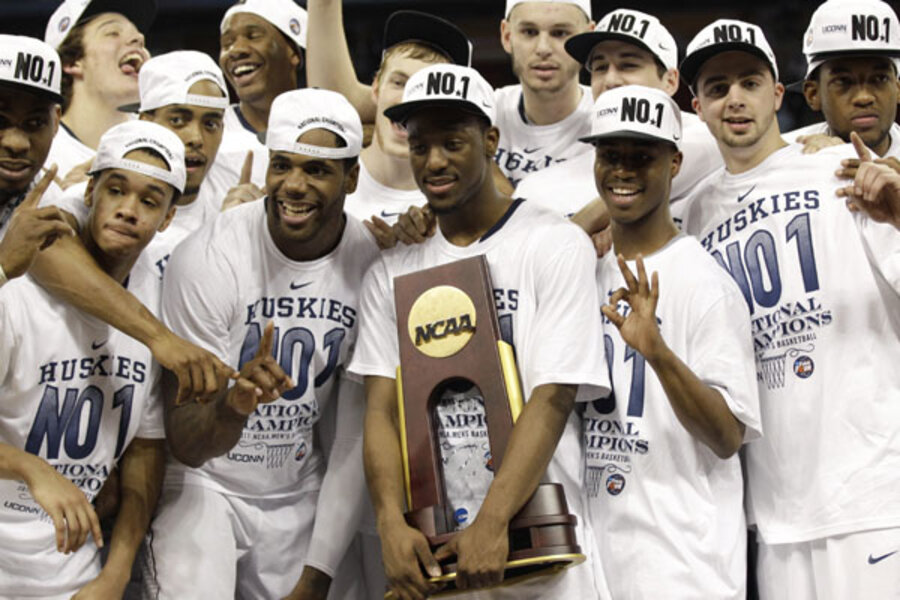March Madness 101: An introduction to the NCAA basketball tournament
Loading...
| Boston
The month of March, beside its reputation as the gateway to spring, is also known for madness – “March” madness, that is. Beginning next Thursday, sixty-four men’s college basketball teams from the NCAA’s Division 1 will compete in this annual ritual that will have both devoted and novice college basketball fans scurrying to fill in their “brackets” to try and determine the winner of college basketball’s national title when the championship game is played in New Orleans on April 2. CBS will broadcast the tournament live throughout - both over the air and on CBSSports.com.
The bracket of teams is set with Sunday night’s selection show, and that promises to be infused with considerable emotion: from the height of elation for those borderline or “bubble” teams making the field, to the depths of disappointment of those having been “snubbed” or otherwise overlooked in the selection process. That process is handled by the NCAA Div. 1 men's basketball committee, made up of university athletic directors and conference commissioners. These so-called “at large” bids, thirty-seven in all, are based primarily on a team’s Ratings Percentage Index; in other words, the strength of its schedule and overall performance against that schedule.
Websites like Rivals.com compute these statistics, which are integral to compiling the teams’ overall rankings. Typically, the lower a team’s RPI, the stronger its chances of receiving an at-large bid. Though RPI has been the generally accepted means of selecting teams for three decades, it is not infallible. Controversies can erupt when partisans of overlooked teams argue that their school’s statistics outweigh those of teams that were accepted. And with so much money and prestige at stake in making the tournament, the perceived subjectivity of the selection committee’s decisions can produce bitter and acrimonious debates.
However, RPI rankings are not the only means by which a team can enter the field. Thirty of the thirty-one remaining slots will be filled with conference champions. These come from both “major” conferences such as the Atlantic Coast Conference (ACC), Big East, Big Ten, etc., and “mid-major” conferences, or those that fall outside the traditional major or “power” conferences. Harvard University, in the tournament for the first time since 1946, is the only exception, as its conference, the Ivy League, does not have a championship tournament.
On the Tuesday and Wednesday immediately preceding the start of the round of 64, there will be a “First Four” playoff in Dayton, Ohio where eight teams (the lowest seeded at-large bids and the lowest seeded automatic bids) will play an elimination round. These games will be broadcast on truTV, beginning at 6:30 p.m. ET.
The four victorious teams then join the other sixty teams in the main tournament, which is divided into four geographic regions, East, West, Midwest and South – each consisting of sixteen seeded teams. The first seed always plays the sixteenth, the second the fifteenth, and so-on. Since the tournament went to sixty-four teams in 1984, a sixteen-seed has never beaten a first – though in 2001, fifteenth-seeded Hampton University defeated second-seed Iowa State. This is part of the appeal of the tournament – trying to correctly spot the “upsets” while simultaneously preserving your “Final Four” teams through to the championship round.
Additionally, it’s a great deal of fun to watch and check in on so many games in the first rounds – thirty-two games broadcast over the first Thursday and Friday that are frenetic, fast-paced and fraught with heartbreak and happiness. There are blowouts and “buzzer-beaters”, the drama of the occasional David-defeats-Goliath contest, tears of joy and sadness, the “pig piles” and court rushings – all concluding with one team’s jubilation in cutting down the nets following the championship game.
For nearly three weeks, this emotional roller coaster will keep college basketball fans riveted to the cathode-ray glow of our national campfire.







